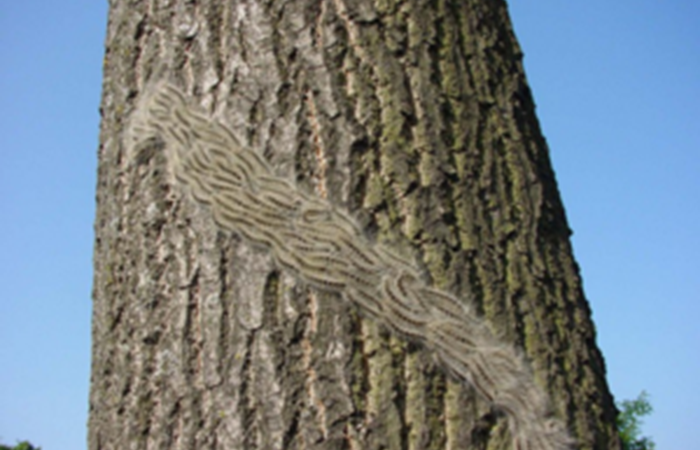Forestry Commission

New legislation to allow the movement of large oak trees and trade within the operational zones and boundaries in place to help manage Oak Processionary Moth (OPM) is being introduced today (24 May).
OPM is a tree pest first identified in London in 2006 which has spread to some surrounding counties in the South-East of England. Its caterpillars feed on the leaves of several species of oak trees, causing them to lose their leaves, negatively impacting their growth, and making them more vulnerable to other stresses, such as drought. When touched by members of the public, they can cause itchy rashes, eye, and throat irritations. The period between June and August provides the greatest risk to health as this is when the caterpillars emerge.
The Forestry Commission has in place operational zones and boundaries aimed at managing OPM. In March, in response to government surveillance, the Established Area in which OPM is established and the Buffer Zone in which an annual programme of OPM management takes place, was expanded.
From today, a new demarcated area will be established around the Buffer Zone and Established Area, enabling large oak trees (girth at 1.2m above the root collar of 8cm or more) to be moved within this boundary, provided that the trees are moved by professional operators and that biosecurity requirements are met along with movement restrictions.
Professor Nicola Spence, UK Chief Plant Health Officer, said:
Healthy oak trees are a vital component of a biodiverse and thriving environmental landscape. They are Great Britains most important tree for species biodiversity, supporting over 2000 species of bird, mammal, fungi, invertebrate, bryophyte and lichen.
This is why it is essential that to protect the health of our oak trees, we have regulations in place for the movement of large oak trees within the zones and boundaries designed to manage Oak Processionary Moth.
Andrew Hoppit, Oak Processionary Moth Project Manager, said:
Oak Processionary Moth is a tree pest which can have a negative impact on tree health, and which can cause itchy rashes, eye, and throat irritations, when in physical contact with humans and pets.
While we understand the importance of professional operators being able to move large oak trees, it is vital that we have in place stringent biosecurity requirements to ensure a risk-based approach for moving these trees.
Large oak trees will be able to be moved within the established area, or into the established area from the buffer zone, providing the following biosecurity requirements are met:
-
Biosecurity competence Professional operators must demonstrate that they meet the Plant Health Management Standard evidenced through membership of thePlant Healthy Certification Schemeor provision of aReady to Plantapproval from Fera Science Ltd for each consignment to be moved. They must also demonstrate evidence of ongoing on-site monitoring for OPM and inspection of OPM prior to movement.
-
Official inspections Professional operators must keep accurate records of the of the contact details of those receiving large oak trees, including the delivery address and contact details. They must store this information for a minimum of three years to ensure traceability of movements. This information can be recorded using thePost planting Inspections form .
Large oak trees will be able to be moved within the buffer zone if they meet two additional biosecurity requirements:
-
Phytosanitary treatments Professional operators must have a robust control regime in place with appropriate phytosanitary treatments. These treatments must be applied in line with Defra Guidance on application of phytosanitary treatments for the control of Oak Processionary Moth (Thaumetopoea processionea) 2023 and records of all treatment applications must be kept for a minimum of three years.
-
Post-planting inspections Professional operators must disclose the potential for post-planting inspection as part of the new legislation to buyers at the time of purchase. A proportion of high-risk large oak movements within the buffer zone will be subject to post-planting inspections by the plant health inspectors.
To protect the area free from the pest it will not be permitted to:
- Move large oak trees with OPM
- Move large oak trees from the Established Area or Buffer Zone into the Area Free from the Pest
- Move large oak trees from the established area into the buffer zone
- Move large oak trees from the established area or buffer zone into the 10km exclusion zone at the outer edge of the buffer zone boundary
A Government programme to manage OPM has been in place since 2012. Over the last five years, 10 million has been invested into oak health, including the management of oak processionary moth, as well as research to develop novel control techniques and new policy responses.
Professional operators who are growing or moving large oak trees, and who are impacted by the new movement restrictions, should consult with their local Plant Health inspector or thePlant Health and Seeds Inspectoratefor further advice. For further information on the new movement restrictions, please view our digital guide and video explaining these changes. Please also view our interactive map showing the locations of recent confirmed reports of OPM and the
